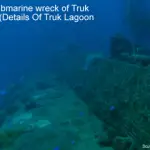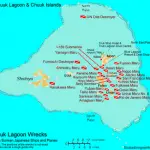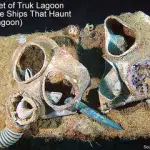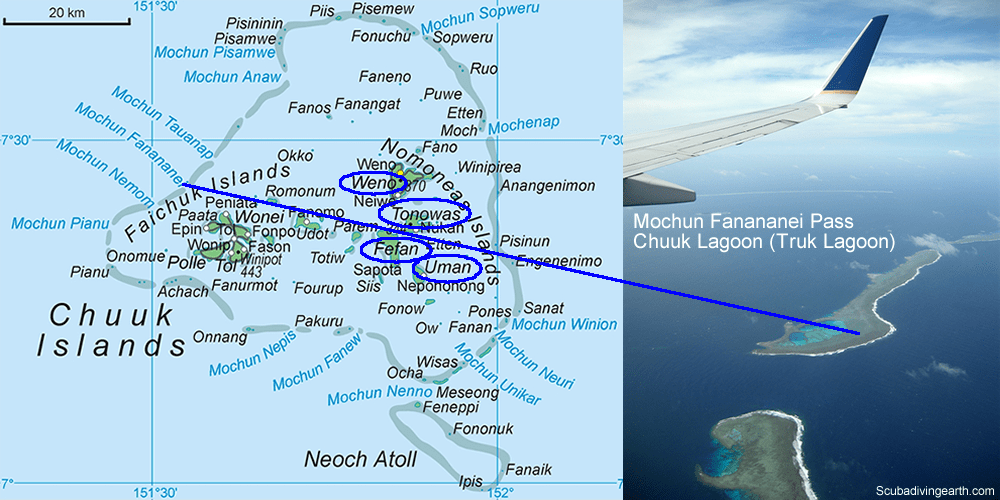
Truk Lagoon diving is on many scuba diver’s bucket list but what happened at this famous lagoon and why is it so popular with scuba divers?
It is what happened at Truk Lagoon that makes this place special for scuba divers from around the world. The Truk Lagoon wrecks left from what happened make for a chance in a life-time dive trip. Truk Lagoon diving is out of this world. But how did the wrecks get there and what happened all those years ago?
What happened at Truk Lagoon happened in 1944 during World War II in Operation Hailstone when the Americans attacked the Imperial Japanese Navy (IJN) stronghold at anchor in the lagoon. The battle of Truk Lagoon lasted for 36 hours, during which 53 Japanese ships were sunk and can still be dived today.
Of the 53 IJN ships suck during World War II around 48 are now dived. Scuba diving the wrecks of Truk Lagoon (or Chuuk Lagoon) is a wreck-diver’s Mecca. However, due to the depths of many of the Truk Lagoon wrecks the diving is for the more advanced deep divers and tech divers to enjoy.
The best way to dive Truk Lagoon is by a scuba diving liveaboard. You can check the latest and best deals on Truk Lagoon liveaboards using the following window:
Truk Lagoon dive liveaboards table
This list of Truk Lagoon liveaboards is in descending customer rating order, followed by Scuba Diving Luxury Rating (SDE Lux Rating, see below), so the liveaboards with the highest customer rating and the best SDE lux rating will be at the top of the list. If you want to change the list order, use the “Sort by” dropdown below.
| Discover Liveaboard | Customer Rating | SDE Lux Rating % | Flexible Booking | Dive Courses | Dietary Requirements | Nitrox | Gear Rental | |
|---|---|---|---|---|---|---|---|---|
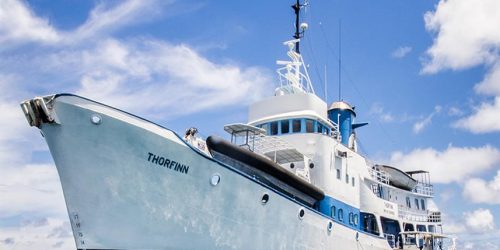 |
Review: SS Thorfinn; Book: SS Thorfinn | 8.8 | 88% | YES | YES | YES | YES | YES |
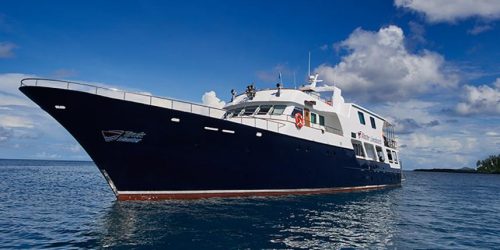 |
Review: MV Truk Master; Book: MV Truk Master | 7.9 | 65% | YES | NO | YES | YES | YES |
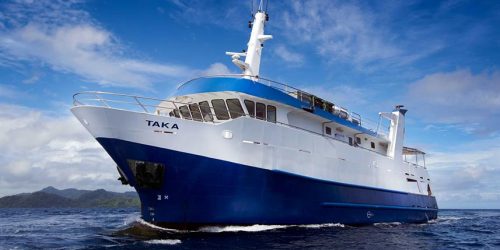 |
Review: MV Pacific Master; Book: MV Pacific Master | 0 | 56% | YES | YES | YES | YES | YES |
The Scuba Diving Earth Luxury Rating (SDE Lux Rating) is explained on each liveaboard review when you click the “Discover Liveaboard” link, and is my own Liveaboard Luxury Rating I’ve assigned to all liveaboards. Choosing between liveaboards is helped by customer scores, and if you get stuck choosing between two or three liveaboards, where each one has a high customer score out of 10, you can use the SDE Luxury Rating to help narrow down your choice.
Think about it like using Booking.com when searching for the best hotel. Booking.com also use a customer score where each customer rates hotels out of 10. This is similar to the liveaboard customer rating, which is also rated out of 10. But let’s say you only like to stay in hotels rated 8 and above on Booking.com, but you also want the hotel to have WIFI or parking, or to have a swimming pool etc. The features each hotel has is usually secondary to the score out of 10.
But before I explain this further, it’s important to understand that Truk Lagoon was renamed Chuuk Lagoon.
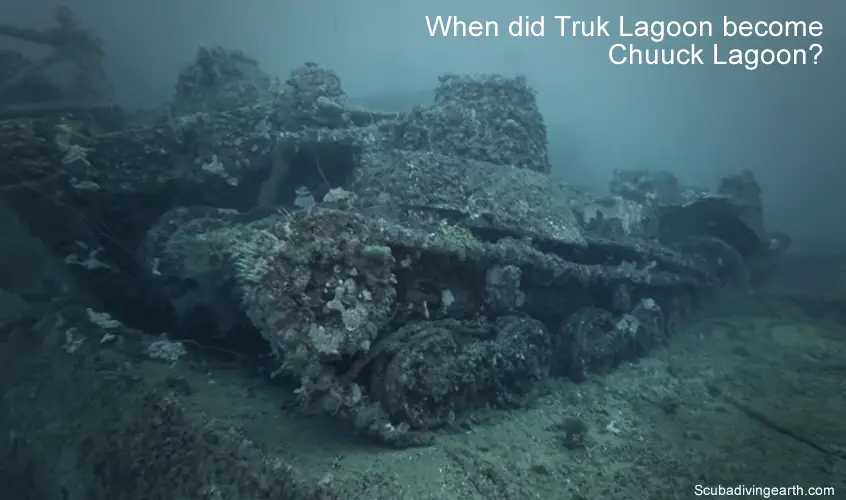
When did Truk Lagoon become Chuuck Lagoon?
The famous lagoon is located in the central Pacific Ocean which has been known for many years as Truk Lagoon. But the lagoon was renamed in 1990 to Chuuk Lagoon.
The name ‘Chuuk‘ means mountain in the Chuukese language. Where Chuukese is also given the name Trukese. This is a Trukic language.
This language, where there are estimated to be 45,900 speakers in Micronesia, is mostly only spoken on the Chuuk Islands and the Caroline Islands in Micronesia. This Chuuk language forms part of the Austronesian language.
But there are also communities that speak this ancient language on Pohnpei, Guam, and on the Hawaiian Islands of America too.
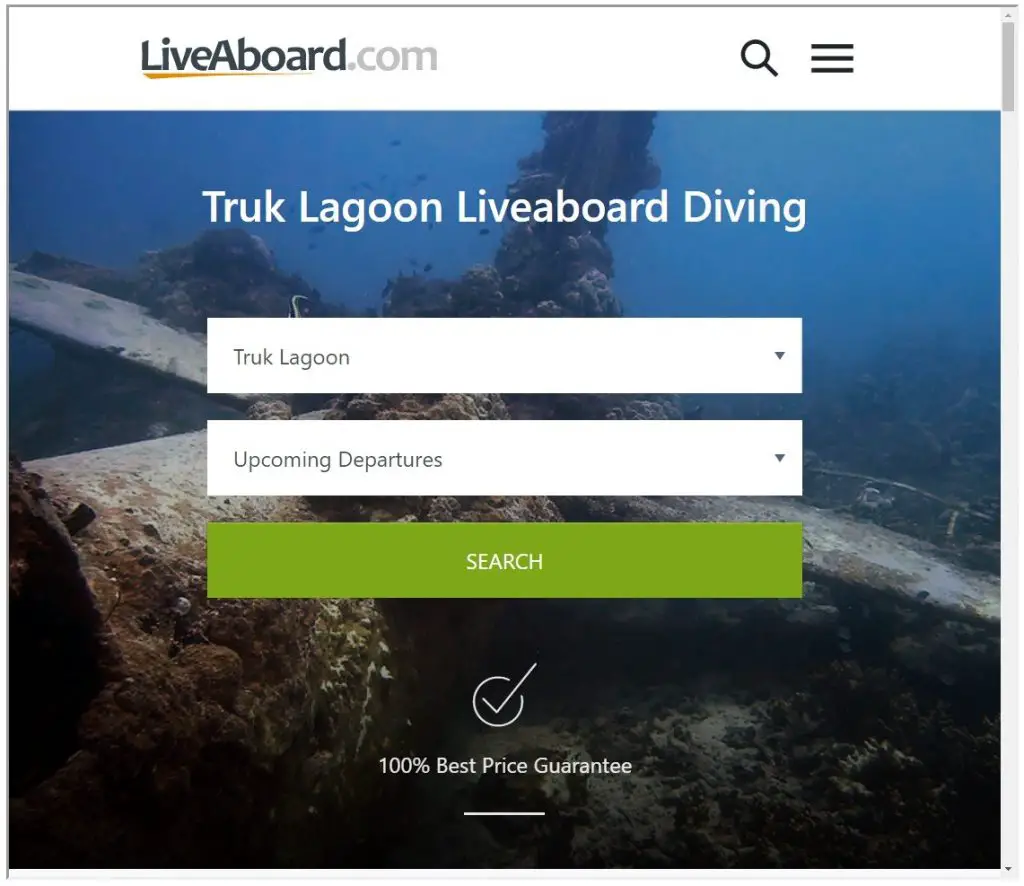
Is Chuuk a country?
Chuuk isn’t a country, but is a state. Chuuk or Truk is one of the four states of the Federated States of Micronesia (FSM). The other states that form Chuuk include Kosrae State, Pohnpei State, and Yap State.
Is Chuuk a US territory?
Chuuk is not a US territory. However, after the War, Chuuk was one of six districts of the Trust Territory of the Pacific Islands which were administered by the United States.
This ‘Trust Territory‘ was put in place under charter from the United Nations at the end of World War II until the early 1990s. It was up to this point that these islands were known as Truk Lagoon, but after this date the name was changed to Chuuk Lagoon.
Today Chuuk is a state within the independent Federated States of Micronesia.
Is Micronesia part of the US?
The Federated States of Micronesia, which is also known simply as Micronesia, is an independent republic, which is associated to the United States.
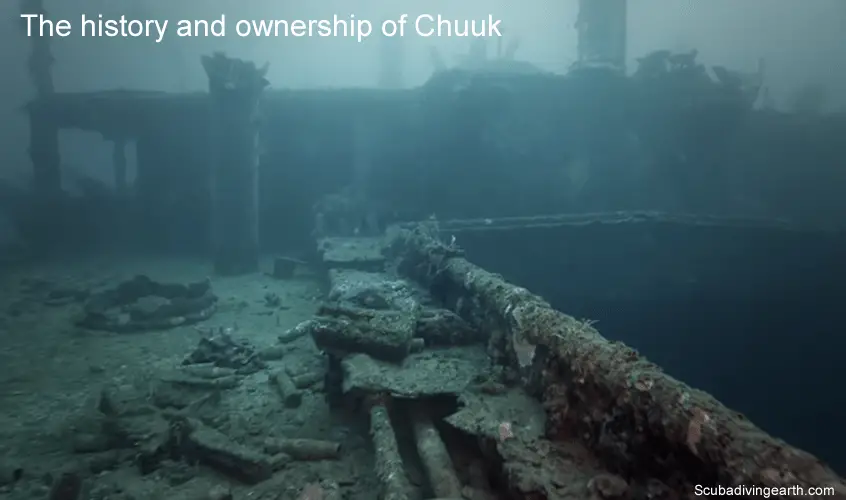
The history and ownership of Chuuk
Chuuk was originally part of the other islands that speak the Chuuk language, the Caroline Islands. Because of the link to the Caroline Islands, Chuuk was a part of the Spanish Empire in the late 19th century. It was then part of the German Empire and finally the Japanese empire.
Interestingly enough, Chuuk became a possession of the Empire of Japan under a mandate from the League of Nations following Germany’s defeat in World War I.
During World War II, Chuuk Lagoon was Japan’s main naval base in the South Pacific. This is where a significant portion of the Imperial Japanese Naval fleet were based.
Its administrative center on Tonoas (south of Weno, both marked on the map above). Some have even described Truk as Japan’s equivalent of the Americans’ Pearl Harbour.
But also, and due to its heavy fortifications which were both natural and man-made, the base at Truk was known to Allied forces as “the Gibraltar” of the Pacific.
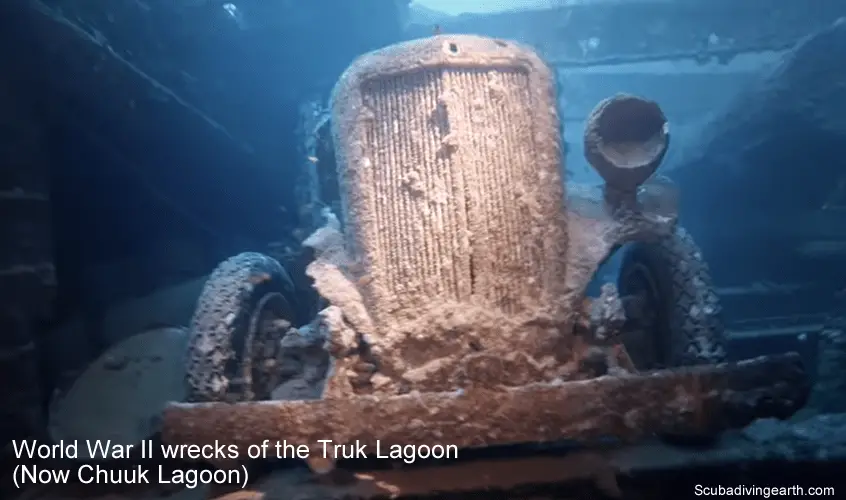
World War II wrecks of the Truk Lagoon (Now Chuuk Lagoon)
During World War II the American forces captured the Marshall Islands, which in today’s terms is a four hour 40 minute flight to Truk Lagoon.
The Americans used the Marshall Islands as a base from which to launch Operation Hailstone. This was an early morning attack on February 17, 1944 against Truk Lagoon and the Japanese fleet.
This operation lasted for three solid days. As a result of the attack the Americans sank approximately 53 Japanese ships and destroyed around 250 planes.
The sunken ships included twelve smaller Japanese warships (light cruisers, destroyers, and auxiliaries) and thirty-two merchant ships.
Here’s a flavour of what Operation Hailstone was like back in 1944 and World War II
This short newsreel, produced for the home market, shows Operation Hailstone, the U.S. assault on “Japan’s Pearl Harbor”, the naval base at Truk. Footage shows Task Force 58, which included the fleet carriers USS Yorktown, USS Essex, USS Intrepid, USS Bunker Hill, USS Enterprise, and the light carriers USS Belleau Wood, USS Cabot, USS Monterey, and USS Cowpens as they strike the Japanese base beginning in February of 1944. Extensive gun camera footage is seen in the film, as well as an astounding shot of a carrier plane making a perfect landing on one wheel. Japanese ships sunk during the Truk raid included the light cruisers Agano, Naka, Katori, and the destroyers Akikaze, Mutsukaze, Harusame, Maikaze, Nowaki, Oite, Sutsuki, Shigure, Tachize and Fumizuki.
As a consequences of Operation Hailstone, the attack made “Truk lagoon” the biggest graveyard of ships in the world. It is thought that more than 3000 people died in Truk Lagoon during World War II. It is said that the souls of those that died are haunting the area.
You’ll see below that on some of the Truk Lagoon wrecks there are still human remains. This definitely adds to the eerie but impressive feeling of the dives there.
Truk Lagoon and human remains resulted from many Japanese sailors going down with their ships. It’s estimated that on one ship alone 400 Japanese soldiers, who were stuck in the cargo hold, were killed when it sunk.
There’s still evidence today of the deaths from this raid on the Truk Islands. As in certain of the wrecks you can see human remains. This includes human skeleton parts like bones and skulls.
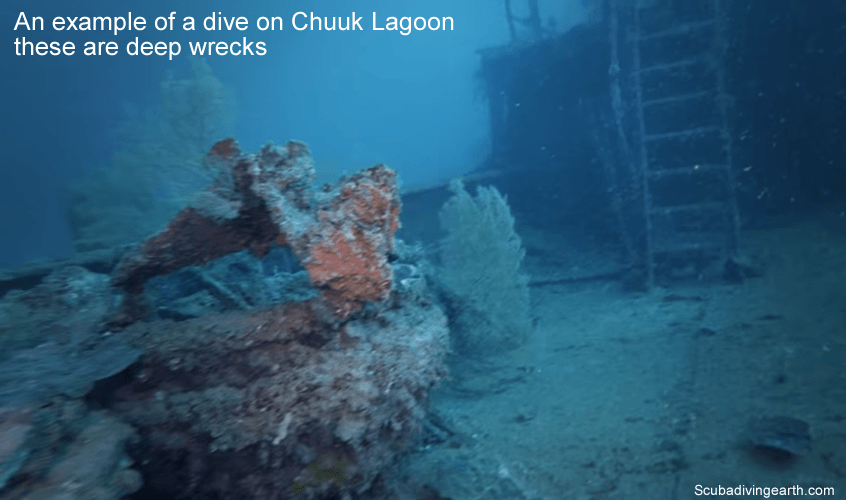
An example of a dive on Chuuk Lagoon – these are deep wrecks
You’ll notice that the scuba divers in most of the videos either have a re-breather or they have a pony cylinder and most have twin sets too.
This is because many of the Truk Lagoon dives are deep dives and they are all likely to be decompression stop dives. Not all wrecks are extremely deep. But even some of the shallower wrecks are in 30 plus metres (100 feet) of water.
This means that in order to spend any reasonable time on these wrecks you really need to consider decompression stop diving. Otherwise your bottom time will be severely limited. Consequently the time spent on the wrecks will be short.
Join me to dive the wrecks in Truk Lagoon in November 2019 or May 2021 in partnership with Lust4Rust Diving Excursions. Truk Lagoon. Footage is available for license contact [email protected] – (Chuuk) is known as one of the best shipwreck diving locations on the planet due to the large number of sunken ships and planes in a sheltered area. In February 1944 the United States Navy launched a large surface and air attack for 3 days called “Operation Hailstone” sinking over 40 ships, and destroying more than 275 planes. Truk was the Japanese anchorage during WWII and the USA took out merchant ships, battleships, destroyers, tankers, minesweepers, and gunboats making this area the largest shipwreck graveyard in the world. This video was shot in December 2017.

Truk Lagoon diving – A Mecca for wreck divers
As explained above, scuba diving the wrecks of Truk Lagoon is deep diving. When I say deep, I mean the majority of the wrecks are deeper that 30 metres (100 feet) deep.
True Lagoon (or Chuuk Lagoon) is definitely a Mecca for wreck divers. You’ll see below a summary of some of the more popular World War II wrecks of Truk Lagoon.
To enjoy the diving on the majority of these wrecks you will need to be a more advanced diver to dive them. Whilst you’ll note when you read the wreck descriptions below that some start quite shallow, the majority are much deeper.
For you to get the most out of your Truk Lagoon diving, it would be beneficial for you to be a Nitrox diver. Or even better, a technical diver who’s used to diving on more advanced mixed gasses.
The water is warm for most of the year. Temperatures ranging from 26 and 30° C (78-86° F). The climate is temperate in the Micronesia area. The dry season runs from December to April, which is the best time for Truk Lagoon diving.
To see the location of the Truk Lagoon wrecks on a map, please follow this link to: Truk Lagoon wreck map. Plus to see how to get to Truk Lagoon, please take a read of this article: How to get to Truk Lagoon.
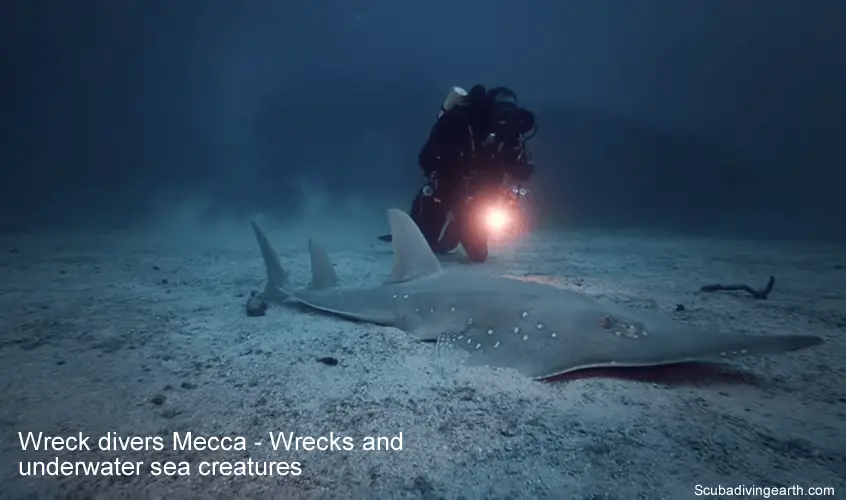
Wreck divers Mecca – Wrecks and underwater sea creatures
Amongst the wrecks themselves, which are impressive by themselves, many of them still have their cargos to explore. Many of these World War II ships were sunk with their cargo in place. This means that their cargo holds are still completely filled
True Lagoon divers will see artefacts ranging from:
- Battle tanks.
- Bulldozers.
- Motorcycles.
- Boxes of ammunition.
- Torpedoes and bombs (shells) and other weapons.
- But you will also see smaller things like cutlery and china wear, bottles of Japanese Sake and other personal belongings, like shoes etc.
But for those of you who also love to experience the wonderful sea life that ship wrecks attract, after so many years of being submerged, each of the Truk Lagoon wrecks have created their own little marine ecosystems.
Depending on the depth of the wreck will depend on how much growth there is to see. But many of the Chuuk Lagoon wrecks have sponges with soft and hard corals growing across the whole superstructure of the wreck.
For those of you who are like myself, you will also experience animal underwater sea creatures too. This includes grey reef sharks, stingrays, eagle rays, turtles, jellyfish and many of colourful, tropical and coral fish.

How deep are the wrecks in Truk Lagoon?
Whilst some of the wrecks can be accessed from around 5-15 metres (16-49 feet) deep, many of the wrecks are very deep. But they are still accessible for recreational scuba divers, as some lie in depths of 30-40 metres (100-130 feet).
However, to spend any reasonable amount of time on these wrecks at this sort of depth, you are probably looking at diving decompression stop dives.
But also, for those technical divers amongst you, some of the wrecks are sitting at 60-70 metres (230 feet). Which would mean using special mixed gases to achieve these depths.
Truk Lagoon or Chuuk Lagoon and wreck diving are synonymous. If you love wreck diving, then you need to add Chuuk Lagoon to your bucket-list. One of the great aspects to diving on these many wrecks in Chuuk is the visibility.
Visibility in the area ranges from 12-30 metres (40-100 feet). This sometimes provides the opportunity to have a stunning view of entire wrecks.
Video of diving Chuuk Lagoon
This video is pretty cool, as the video over-lays images and names of the wrecks sitting on the sea bed at Chuuk Lagoon.
A couple of days diving some of the best wrecks in the world!
Now that you’ve had a taste of what the Chuuk Lagoon wrecks look like on video, here’s a description of the wrecks you can dive.
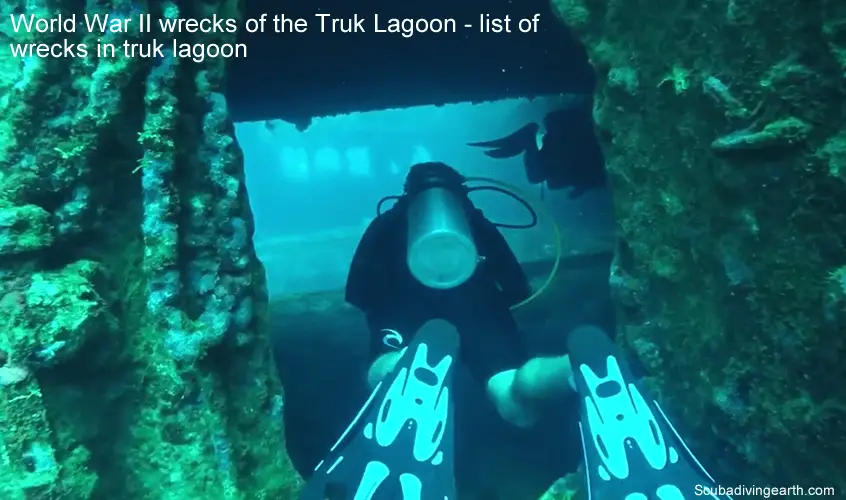
World War II wrecks of the Truk Lagoon – list of wrecks in Truk Lagoon
Note that in 1944 during World War II the Americans sunk and destroyed over 220,000 tons of Japanese shipping!
But also, please bear in mind that Chuuk Lagoon is a grave site too. You will need to respect this when you dive the site. So by what happened at Truk Lagoon is what’s resulted in the following list of wrecks in Truk Lagoon.
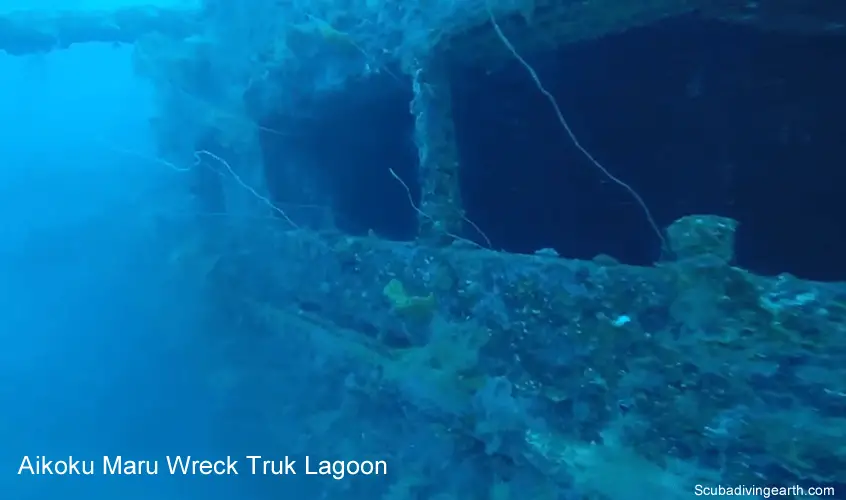
Aikoku Maru wreck
The first World War II wreck of True Lagoon is Aikoku Maru.
- The Aikoku Maru was a converted passenger freighter, sitting upright, with her fore ship destroyed.
- It has AA guns and a huge stern gun and personal artefacts.
- This wreck lies at a depth of 24-64 metres (79-210 feet).
- The Aikoku Maru has a length of 151 metres (495 feet) and weighed in a 10,437 tons.
Video of Aikoku Maru wreck
Underwater video of the wreck of Aikoku Maru, one of the many Japanese shipwrecks at Truk Lagoon.
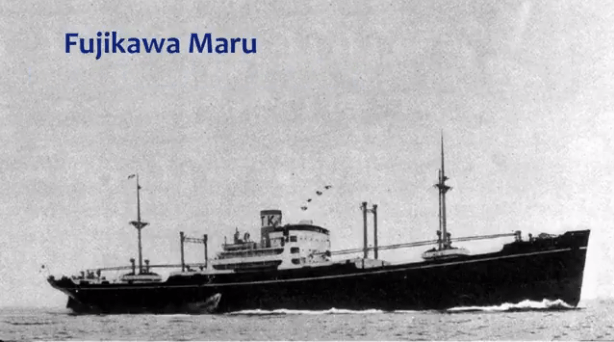
Fujikawa Maru wreck
The Fujikawa Maru was a passenger cargo ship and is sitting upright on the sea bed.
- There are aircraft parts, fuel drums, shells, guns and many artefacts in forward holds.
- It has a very interesting engine room and huge deck guns on the bow and stern.
- This ship had a length of 131 metres (430 feet) and weighed 6,938 tons.
- It has excellent coral growth and plenty of fish life.
- This wreck sits at a depth of 5-37 metres (15-120 feet).
Video of Fujikawa Maru wreck
Underwater video of the remains of the Fujikawa Maru, one of the many Japanese ships sunk at Truk Lagoon in 1944.
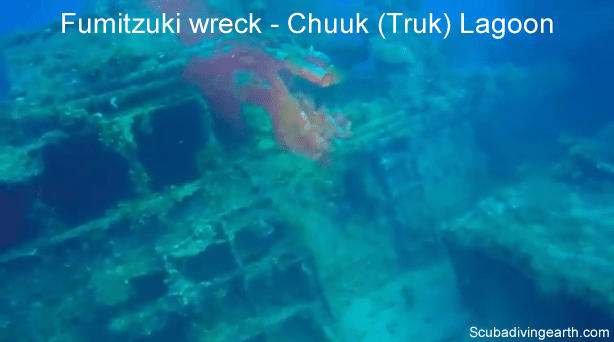
Fumitzuki Destroyer wreck of Truk Lagoon
The Fumitzuki was a Mutsuki Class Destroyer.
- The Fumitzuki Destroyer was an improved version of the Kamikaze-class destroyer.
- These were the first destroyers with triple 61 centimetre (24 inches) torpedo tubes.
- She sits upright on the sea bed, but is listing to port.
- There is extensive marine growth on her hull with many schools of fish to see. She is at a depth of 30-40 metres (100-130 feet).
- The Fumitzuki Destroyer was built in 1926 and is 97 metres (320 feet) in length, with a gross tonnage of 1,913.
Video of Fumitzuki Destroyer wreck
Diving the IJN Fumizuki in Chuuk Lagoon (25th September 2017) with Indepth Scuba and Truk Master
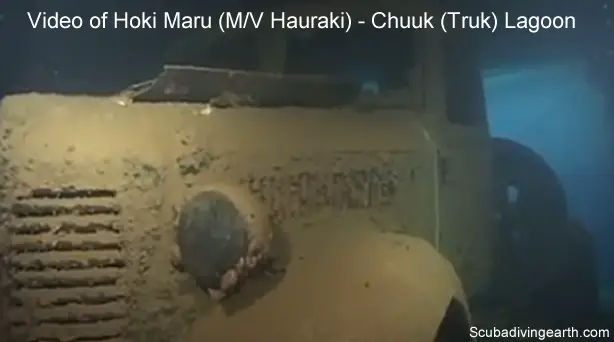
Hoki Maru wreck
The Hoki Maru was a New Zealand cargo ship, which was captured by the Japanese.
- Her original name was the M/V Hauraki, She was 136 metres (450 feet) long with a gross tonnage of 7,112 tons.
- The ‘M/V Hauraki’ is sitting upright, but the main section is broken up from the blast to her when she was sunk by the Americans.
- The aft hold is the main attraction to scuba divers. These are packed with trucks, bulldozers, a tractor, a steamroller, depth charges and radial engines.
- She sits in a depth of between 24-50 metres (80-165 feet).
Video of Hoki Maru (M/V Hauraki) wreck
This is an excerpt from the documentary film, The Wrecks of Truk Lagoon. This segment is on the wreck of the Hoki Maru.
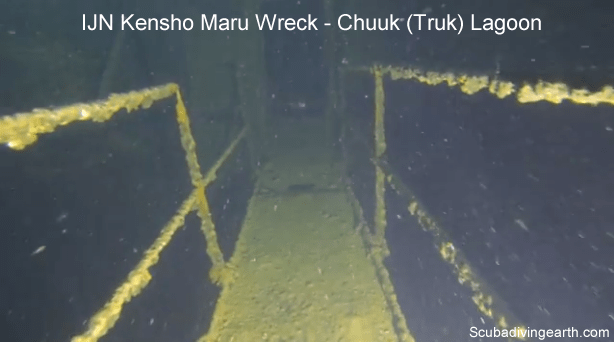
IJN Kensho Maru wreck
The IJN Kensho Maru was a passenger cargo ship.
- She sits at a depth of 12-40 metres (40-130 feet) and lies with a slight list to port.
- Kensho Maru has many artefacts in her superstructure and she has a particularly interesting engine room.
- IJN Kensho Maru was 116 metres (384 feet) in length and weighed 4,862 tons.
- She was built for Inui Kisen K.K. of Kobe, Japan in 1938.
Video of IJN Kensho Maru wreck
A guided tour of this stunning shipwreck engine room – they don’t get much more like the day the ship went down than this.
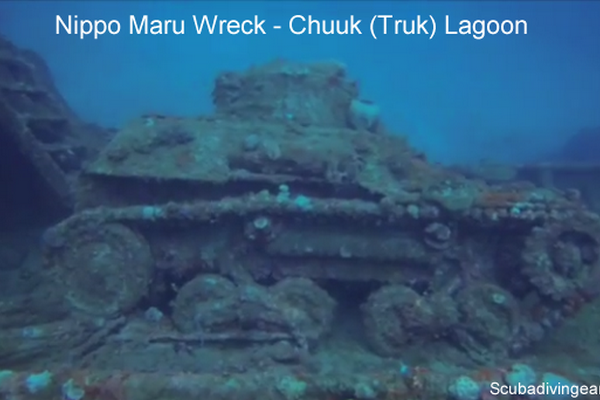
Nippo Maru wreck
The Nippo Maru was a heavily laden cargo ship when she was sank on 17th February 1944.
- She is sitting upright in 18-48 metres (60-180 feet) of water.
- On-board she had coastal defence guns, field artillery, trucks, a tank, machine guns, shells, mines.
- Nippo Maru has a particularly photogenic bridge.
- She was sunk by three 500lb bombs by the American TBF Avengers aircraft.
- She was 108 metres (354 feet) in length and had a 3,764-ton cargo carrying capacity.
- Nippo Maru was first launched in Kobe, Japan in 1936.
Video of Nippo Maru wreck
Nippo Maru – Cargo ship heavily laden, sitting upright. Coastal defence guns, field artillery, trucks, tank, machine guns, shells, mines and photogenic bridge.
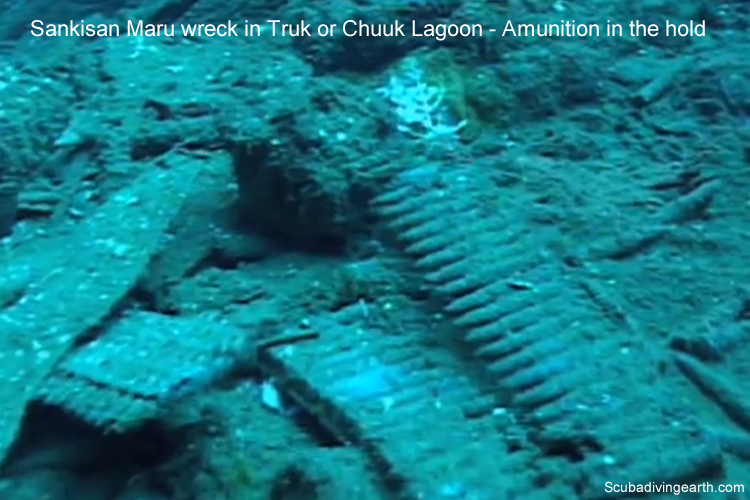
Sankisan Maru wreck
The Sankisan Maru wreck was a cargo ship.
- Her aft is at a depth of 1-27 metres (3-90 feet) and is sitting upright. But the stern is down at 48 metres ( 160 feet).
- Most of her aft section is missing due to a huge explosion when she was finally sank.
- Sankisan Maru was sunk on 18th February 1944 after being hit by a torpedo.
- The fore ship has beautiful coral growth and plenty of fish life.
- You’ll see truck frames, plane parts, ammunition, ink and medicine bottles.
- She was a 112 metres (370 feet) 4,776 ton Japanese cargo ship.
Video of Sankisan Maru wreck
Truk Lagoon Odyssey — Trip Report Our expedition to Truk Lagoon in fact was a chance. The destination of our journey would be Bikini
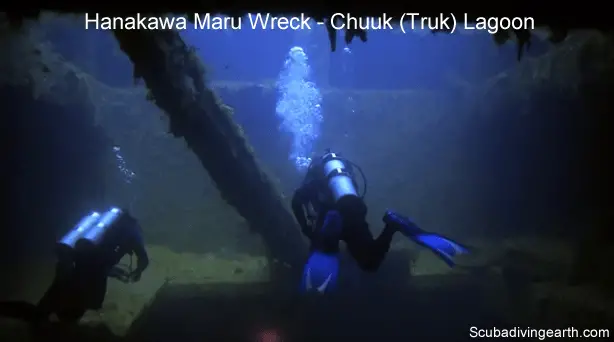
Hanakawa Maru wreck
The Hanakawa Maru wreck was a passenger Cargo ship.
- She is sitting upright in around 15-30 metres (50-100 feet) of water.
- There are fuel drums and cement bags in the holds, which is all part of the wreckage.
- The Hanakawa Maru wreck is covered in soft corals. You see in the video below.
- The Hanakawa Maru was a 112 metres (368 feet) long ship, weighing in at 4,739 tons.
- She was built in 1942 for Kawasaki Kisen Kaisha of Kobe, Japan.
Video of Hanakawa Maru wreck
Hanakawa Maru Truk Lagoon July 2014
Nagano Maru wreck
The Nagano Maru wreck was a passenger cargo ship.
- This wreck is sitting upright in 42-64 metres (140-210 feet) of water.
- In the hold you’ll see an intact truck, construction trailers and timbers, plus some cooking kettles on deck.
- The Nagano Maru was 105 metres (345 feet) in length and weighed in at 3,824 tons.
- She was built for the prestigious Nippon Yusen Kaisha (N.Y.K. Line) of Tokyo, Japan in 1917.
Video of Nagano Maru wreck
Underwater video of the remains of the cargo liner Nagano Maru, one of the many Japanese ships sunk at Truk Lagoon in 1944.
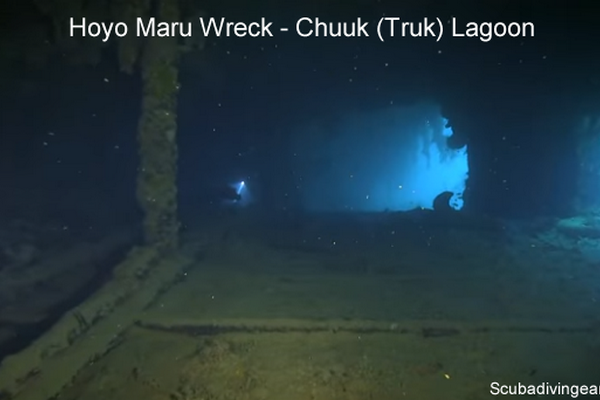
Hoyo Maru wreck
The Hoyo Maru wreck was a tanker.
- At the time she was sunk, she was undergoing repairs due to being torpedoed in November 1943.
- She finally came to rest on the seabed on 17 February 1944.
- As she sank, she capsized and now she lies upside down with a broken back.
- The engine room is damaged. But still accessible by scuba divers and the main hull is covered in hard corals.
- The Hoyo Maru wreck is sitting at a depth of 3-30 metres (9-100 feet).
- She is 145 metres (475 feet) in length and weighed 8,691 tons.
- She was built in 1936 originally as a commercial oiler.
- The Hoyo Maru was requisitioned by the Japanese Navy in 1941.
Video of Hoyo Maru wreck
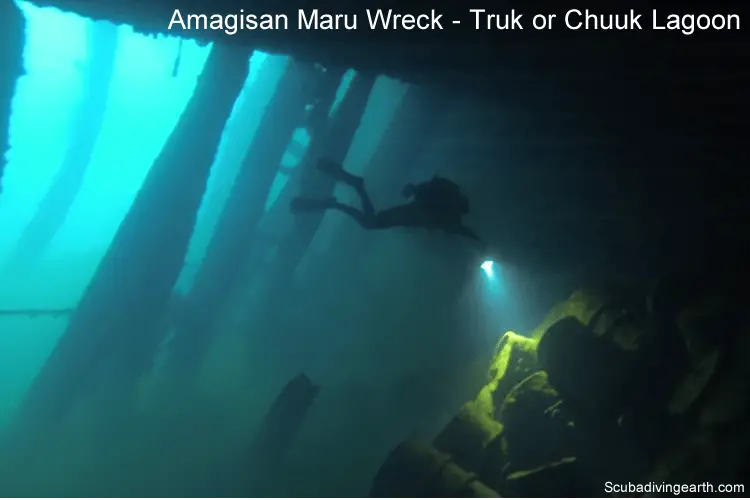
Amagisan Maru wreck
The Amagisan Maru was a passenger cargo ship.
- She sits at 25-55 metres (80-180 feet) of water.
- Where she sits on the seabed, she has a strong list to port.
- She has a large bow gun, trucks in the hold, aircraft parts and a staff car in front hold.
- The Amagisan Maru wreck was a large ship, with a length of 136 metres (450 feet).
- She weighed in at 7,620 tons.
- The Amagisan Maru was built in 1933 by Mitsui Bussan Kaisha of Tokyo.
Video of Amagisan Maru wreck
Beautiful wreck. Lies at a 45 degree. Launched in 1933. Registered in the Imperial Japanes Navy 1941.
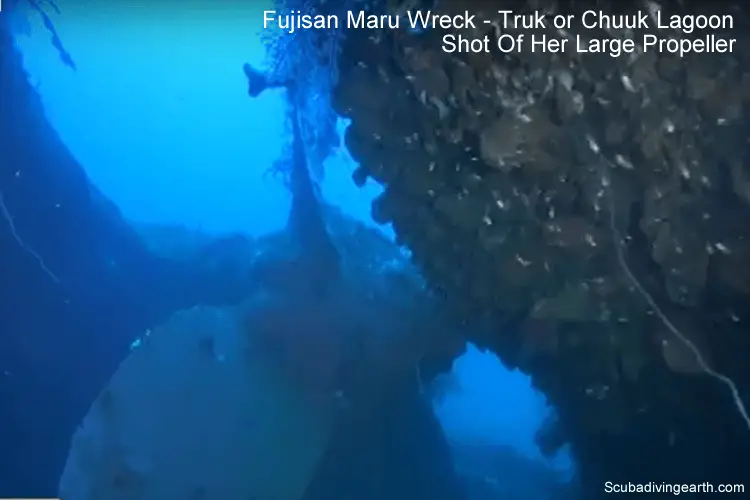
Fujisan Maru wreck
The Fujisan Maru wreck was a naval tanker and was underway when she was sunk on 17th February 1944.
- Sitting in deeper water at between 36-60 metres (120-200 feet), she is one of the deeper wrecks of Chuuk Lagoon.
- The Fujisan Maru is sitting upright, but with a strong list to port.
- If you like to penetrate wrecks when you dive, the engine room is accessible through hull plates.
- The bridge is still intact on what was one of the largest ships in Truk Lagoon at the time of Operation Hailstone.
- She was 156 metres (512 feet) long.
- You’ll be able to see the huge propeller of this large ship. The propeller is shown in the above image and can also be seen in the video below.
Video of Fujisan Maru wreck
Underwater video of the wreck of Fujisan Maru, one of the many Japanese shipwrecks at Truk Lagoon.
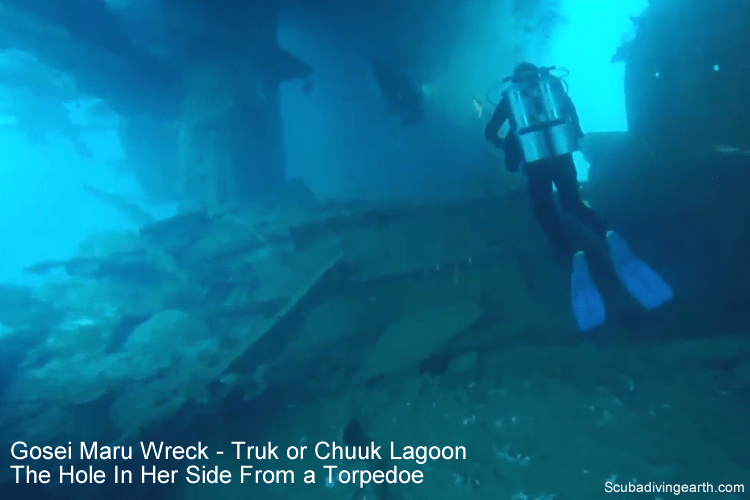
Gosei Maru wreck
The Gosei Maru wreck was a cargo ship.
- She is lying in between 3-37 metres (9-120 feet) of water.
- She is lying on her port side on a very steep incline as can be seen by the range of depths of the dive.
- Before she sank on 17 February 1944, the Gosei Maru had off-loaded the majority of her cargo.
- All that remains in the holds are some torpedo bodies, shells, lanterns and empty fuel drums.
- The propeller of this 82 metre (272 feet) ship is in shallow water.
- She would have been 1,931 tons.
- On this dive on the Gosei Maru wreck you’ll see plenty of fish and coral life.
Video of Gosei Maru wreck
The 1,931grt standard coastal freighter Gosei Maru was built in 1937 and requisitioned by the Imperial Japanese Navy in 1941. She was anchored off Uman Island in Truk Lagoon on 17 February 1944 as aircraft from the surprise U.S. Task Force 58 Operation Hailstone swept across the lagoon destroying Japanese fighter cover. She took an aerial torpedo hit from a USS Monterey torpedo bomber and began to roll over onto her port side. Being ‘light’ she sank quickly with no time for her lifeboats to be launched.
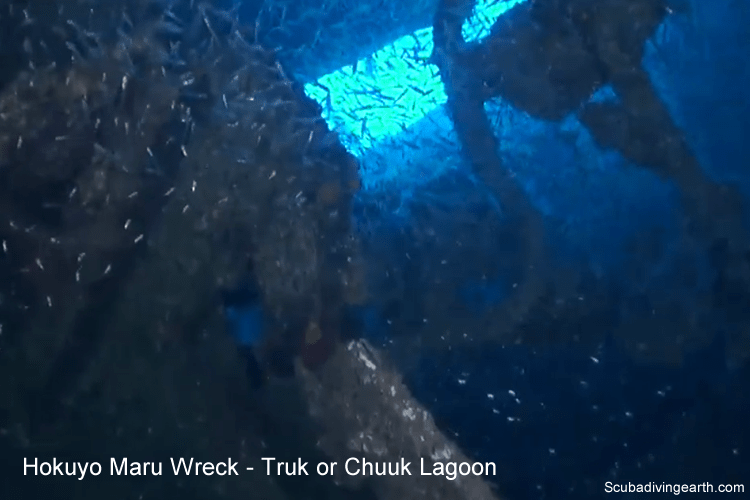
Hokuyo Maru wreck
The Hokuyo Maru wreck was a passenger freighter and became a naval auxiliary ship.
- The Hokuyo Maru was also sunk on 17th February 1944 by the Americans during Operation Hailstone.
- This wreck is sitting upright in 42-64 metres (140-210 feet) of water.
- Hokuyo Maru has an interesting bridge and engine room.
- This ship was a 112 metre (368 feet) long ship weighing in at 4,739 tons.
Video of the Hokuyo Maru
Underwater video of the shipwreck of the freighter Hokuyo Maru, one of the many Japanese shipwrecks at Truk Lagoon.
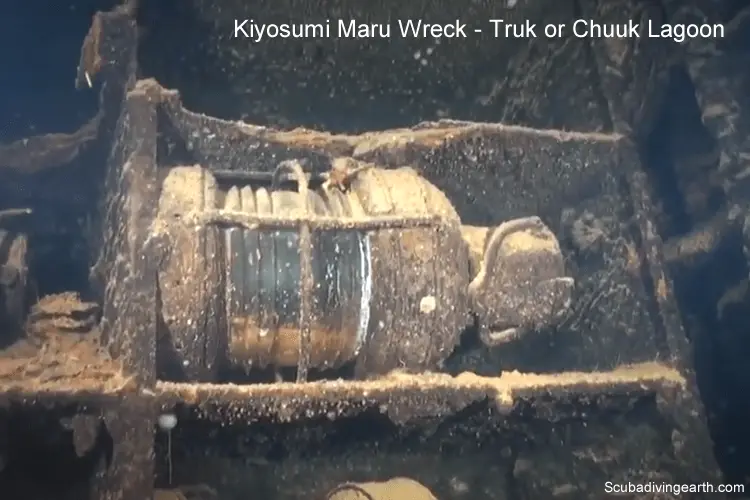
Kiyosumi Maru wreck
The Kiyosumi Maru ship was sunk by American aircraft on 17th Febary 1944.
- She was a passenger cargo ship, but was converted to a Merchant Cruiser.
- Kiyosumi Maru is lying in 12-33 metres (40-110 feet) of water on her port side.
- She had been attacked by submarine torpedoes. This has given her some large torpedo holes in her hull.
- Kiyosumi Maru was in the process of being repaired at Truk Lagoon when she was finally sunk by American aircraft.
- Scuba divers will see AA guns, gun turrets, bicycles, shells and various other interesting artefacts.
- The Kiyosumi Maru was 137 metres (453 feet) long and weighed 8,614 tons.
- She was built in 1934 for Kokusai Kisen K.K. This was a major Tokyo-based shipping company at the time.
More Reading: Recovery of the Junkers Jumo 211 (recovery of underwater artifacts)
Video of Kiyosumi Maru wreck
Underwater video of the wreck of Kiyosumi Maru, one of the many Japanese shipwrecks at Truk Lagoon.
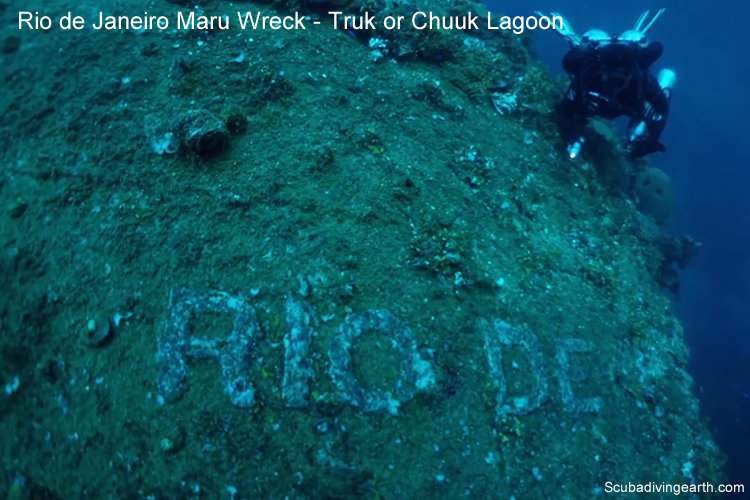
Rio de Janeiro Maru wreck
The Rio de Janeiro Maru wreck was a 140 metre (461 feet) long passenger liner.
- She is lying on her starboard side in 10-33 metres (35-110 feet) of water.
- You can even see a part of the name of the wreck on its hull.
- She was sunk on 17 February 1944 by US aircraft.
- Points of interest for scuba divers include a huge stern gun, several large gun turrets and gun barrels in the holds.
- There are also many beer bottles and there’s good access to the wreck with an interesting engine room.
- The Rio de Janeiro Maru had a gross tonnage of 9,626 tons.
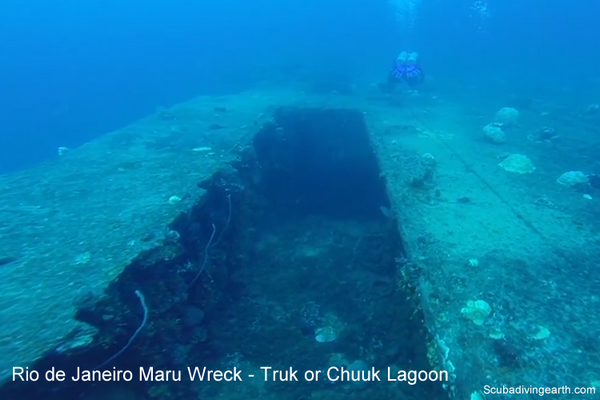
Video of Rio de Janeiro Maru wreck
A tour of the wreck of the 9,600grt passenger cargo liner Rio de Janeiro Maru at Truk Lagoon. Built in 1929 she was requisitioned for use as a Japanese auxiliary transport during WWII. She was bombed and sunk on 17 February 1944 by U.S. aircraft flying from the 9 carriers of Task Force 58 during the 2-day surprise raid codename Operation Hailstone.
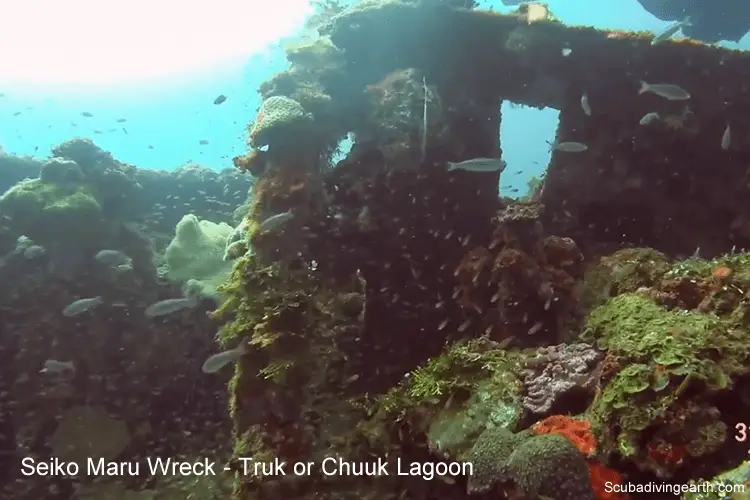
Seiko Maru wreck
The Seiko Maru wreck was a 119 metre (394 feet) freighter, weighing 5,385 tons.
- She is sitting upright in 23-50 metres (75-160 feet) of water.
- There are still torpedoes to see in the holds and a field gun on her bow.
- There are also china and other artefacts in superstructure to be seen on this dive.
- She was built just four years before she was sunk for the prestigious Dairen Kisen Kabushiki Kaisha.
- The Seiko Maru had been crippled when submarine USS Steelhead torpedoed her in 1943.
- She had been floating dead in the water until she was eventually towed 243 miles to Truk for repairs.
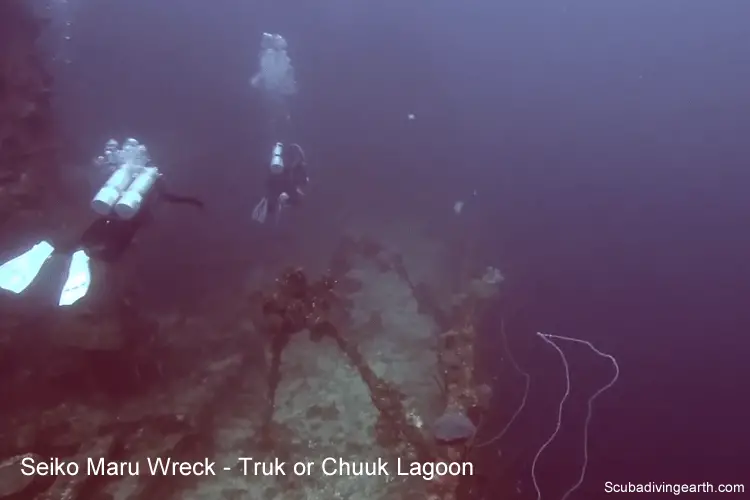
Video of the Seiko Maru wreck
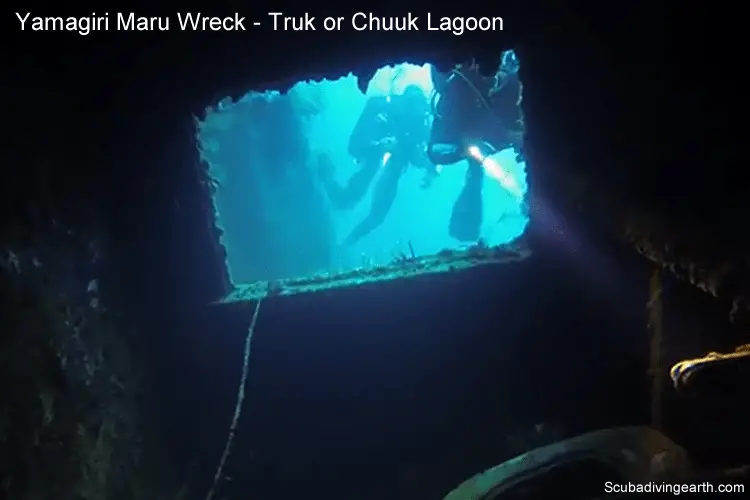
Yamagiri Maru wreck
The Yamagiri Maru wreck was a 133 metre (439 feet) passenger cargo ship.
- She was 6,438 tons and built in 1938 for Kobe-based Yamashita Steamship Company.
- Yamagiri Maru is lying in 12-33 metres (40-110 feet) of water on her port side.
- There are huge shells and construction equipment in her aft hold.
- Scuba divers can also penetrate the superstructure to see her interesting engine room.
- She was finally sunk on 18th February 1944, on the second day of Operation Hailstone.
Video of Yamagiri Maru wreck
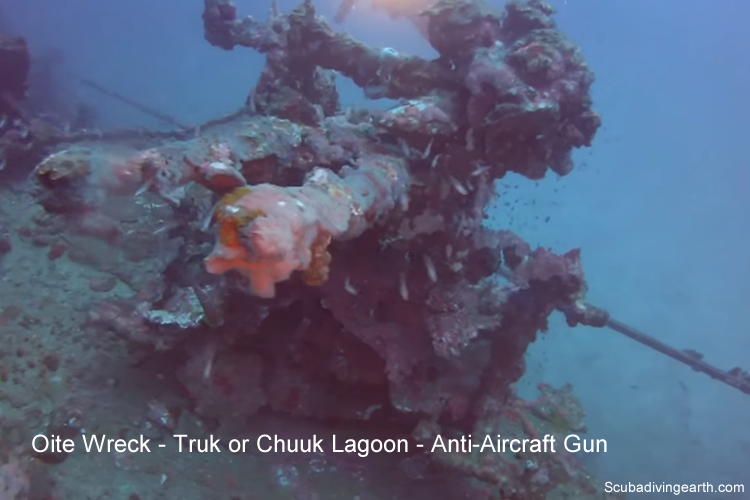
Oite wreck
The Oite wreck was a Kamikaze Class Destroyer and was sunk on 18th February 1944.
- It’s wrecks like this one which highlight how Truk Lagoon is a graveyard.
- When the Oite sank there were only a few survivors from the nearly 700 crew on board her when she sunk.
- The Oite Destroyer was sunk by Avenger Torpedo bombers.
- She was broken in two when a torpedo hit the aft of the bridge.
- Still broken in two with the forward and medium section upside down on the sea bed sitting in 50-62 (170-205 feet) metres of water.
- The Oite Destroyer was 100 metres (327 feet) long and a 1,523 ton ship, and was built in 1924 by the Uraga Dock Co., Ltd of Tokyo, Japan.
- For those of you who like to see guns, there is one of the 4.7 inch guns on the deck, as shown in the above image and in the video below.
- In addition to this gun there were two 7.7mm guns, 2 pairs of 21-inch torpedo tubes, 4 depth charge throwers (see video below), and 18 depth charges on board.
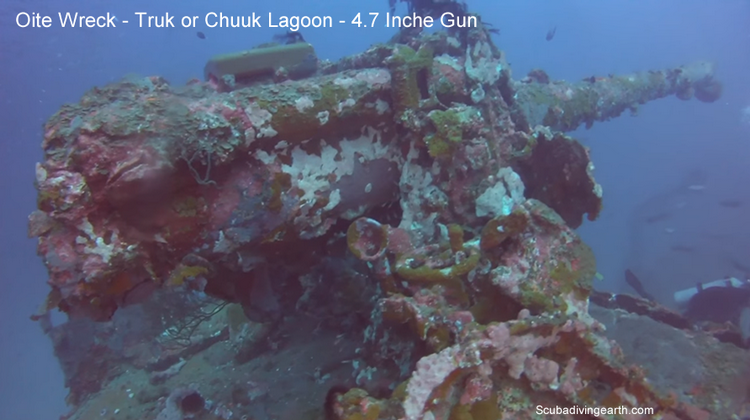
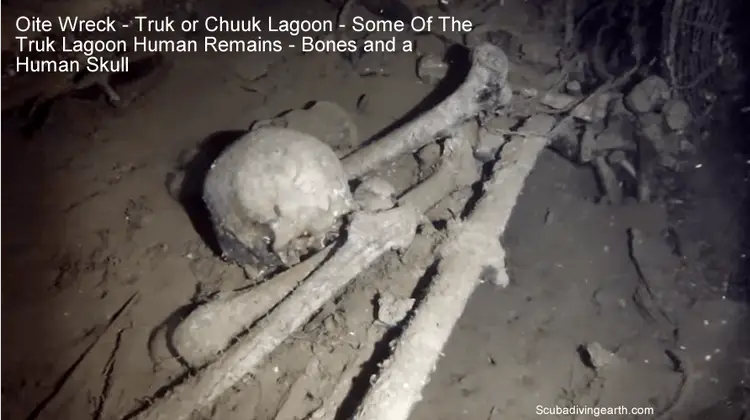
But also be aware, as also shown in the video below, that you may see human remains on this wreck.
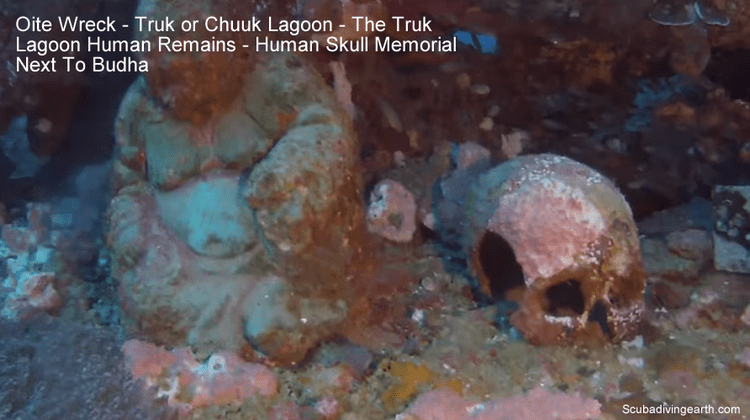
The more Truk Lagoon human remains as a memorial to the lives of the Japanese naval crew, next to a Buddha.
Video of Oite wreck
Something to note towards the end of this video of the dive on the Oite wreck is the decompression time. This was 54 minutes!
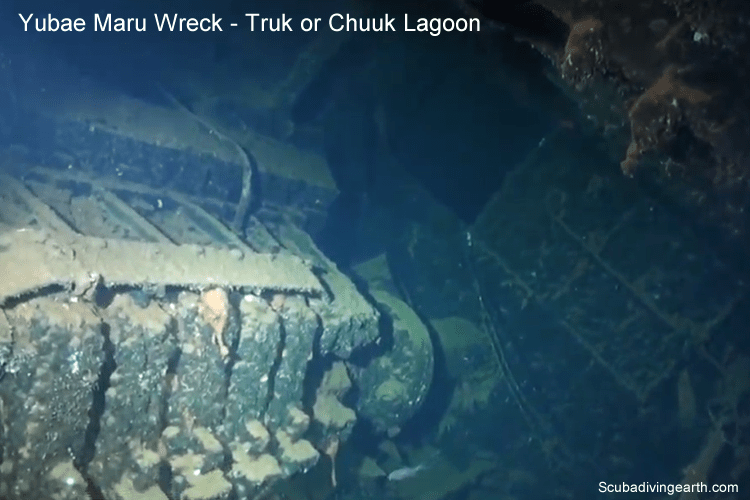
Yubae Maru wreck
The Yubae Maru was sunk on 17th February 1944 by US aircraft during Operation Hailstone.
- Yubae Maru was an army cargo ship built in 1919.
- She measures 105 metres (344 feet) and weighing 3,217 tons.
- She was built by Ishikawajima SB co.
- Yubae Maru is lying on her port side in 18-37 metres (60-120 feet) of water.
- Yubae Maru had only arrived in Truk Lagoon about a week before she was sunk by American Forces.
- Scuba divers will enjoy the many artefacts, which includes china, a sewing machine and an anchor in the forward hold.
Video of the Yubae Maru wreck
Underwater video of the wreck of Yubae Maru, one of the many Japanese shipwrecks at Truk Lagoon.
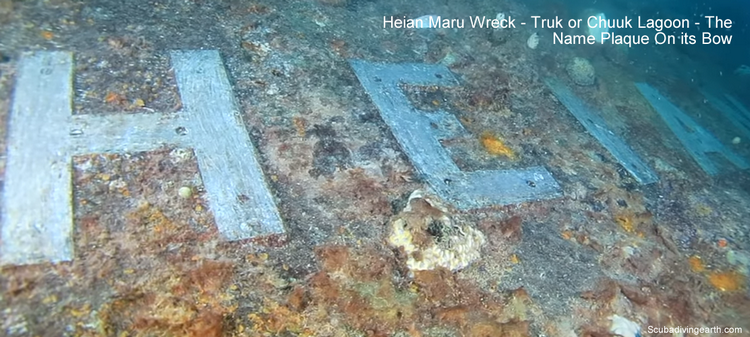
Heian Maru wreck
The Heian Maru was a submarine tender, which was a converted passenger liner.
- She is the largest of this ghost fleet to be sunk by American Forces during Operation Hailstone standing in at 155 metres (510 feet).
- Heian Maru is lying in 11-33 metres (35-110 feet) of water on her port side.
- Inside the superstructure you’ll see shells (bombs), torpedoes, submarine periscopes, china plates, Sake bottles, medical kits, a bath tub, a radio room and many other artefacts. See the video below.
- Her name can be clearly seen on the side of her hull.
- You can also see her huge propellers too.
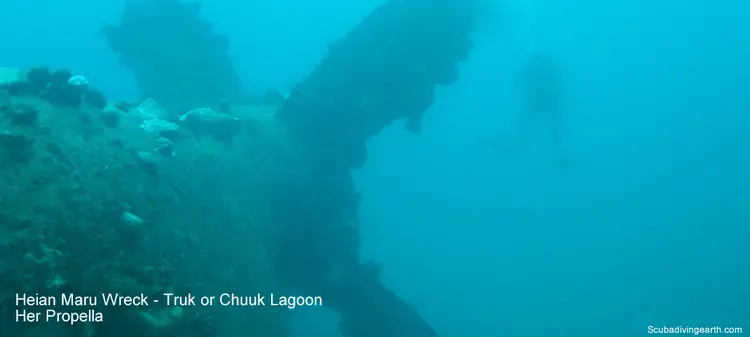
This 11,614-ton Passenger-Cargo Ship was built in 1930 at a cost of $15,000,000! This amount of money in 2019 would be worth over $227,000,000!
Video of the Heian Maru wreck
The Heian Maru – one of the largest wrecks to be found in the waters of Truk (Chuuk) Lagoon at a length of 155m. Built in 1930 as a Passenger-Cargo Ship with interior decoration designed in the “old English” style she was considered a major innovation in ships at the time with the high standards of decoration carried out in the ship’s lounge, reading room, writing room, and dining salon. On her maiden voyage, she set a trans-Pacific speed record on a trip to Seattle. Seattle shippers spread the word through the media that the arrival of the new ship might be regarded as a gesture of friendship from the business interests of Japan. Following this theme of friendship, the ship’s owners opened up the Heian Maru to the public, letting nearly 15,000 people tour the vessel. The crowds were so great that hundreds had to be turned away. She was converted into a Navy submarine tender in 1941, and was an integral part of the 6th Submarine Fleet initially based in Kwajalein, and subsequently stationed at Truk.

I-169 Submarine wreck
The I-169 Submarine is a Class I 168 Kadai Submarine sitting upright in 27-43 metres (90-140 feet) of water.
- Unfortunately there are no penetrations of this submarine wreck.
- Although you’ll see on this article, there’s a video of a scuba diving getting inside the I-169 Submarine.
- The entire crew were lost when this submarine submerged on 2 April 1944. This happened when a second air raid took place on Truk Lagoon.
- The submarine developed problems when it submerged, never to surface again. The entire crew on-board suffocated.
- The severely damaged bow and conning tower happened as a result of Japanese depth charges.
- The Japanese were attempting to destroy her for fear of this submarine being captured by Allied Forces.
- The I-169 Submarine was 102 metres (337 feet) in length and weighed 1,400 tons.
- The I-169 Cruiser-Submarine was launched on February 15th, 1934 and is thought to have been a part of the Pearl Harbour attack.
Video of the I-169 Submarine wreck
Our expedition to Truk Lagoon in fact was a chance. The destination of our journey would be Bikini Atol, but with the closure of operations of that island diving, the tickets already issued and paid up to Honolulu and vacation already scheduled, we had no doubt to try to find an alternative to Bikini .. . and the gods of diving conspiring in our favour, our destination was changed to Truk LAGOON – THE SHIPWRECK DIVING CAPITAL OF THE WORLD!
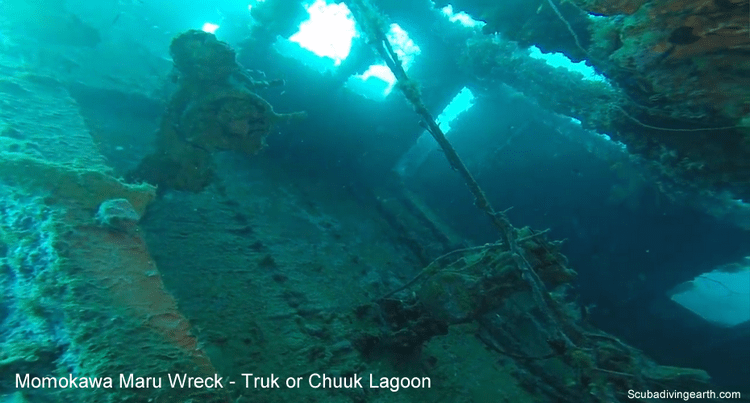
Momokawa Maru wreck
The Momokawa Maru arrived in Truk Lagoon on 4th February 1944.
- She was towing the damaged IJN transport Kensho Maru ship. She was requisitioned in 1942 as an auxiliary transport vessel.
- On the first day of attack by US Task Force, 58 aircraft lightly damaged her on 17th February 1944.
- It was on the second day of Operation Hailstone that she was attacked by Curtiss Helldiver dive bombers from the fast aircraft carrier USS Bunker Hill.
- She was hit by a 1,000lb bomb amidships and soon sank rolling to her port side.
- Momokawa Maru was a passenger cargo ship.
- She is lying on her port side in 27-40 metres (90-130 feet) of water.
- The forward hold is full of plane parts, trucks and shells. She has an interesting bridge and galley.
- The Momokawa Maru was 107 metres (354 feet) long ship weighing in at 3,829 tons.
- Momokawa Maru was built in 1941 by Kawasaki Dockyard Co. Ltd., Kobe, for the ‘K Line’ shipping company.
Video of the Momokawa Maru wreck
A dive on IJN naval auxiliary transport vessel Momokawa Maru sunk at Truk Lagoon on 18 February 1944 during Operation Hailstone by Task Force 58 Curtiss Helldiver dive bombers from the fast carrier USS Bunker Hill
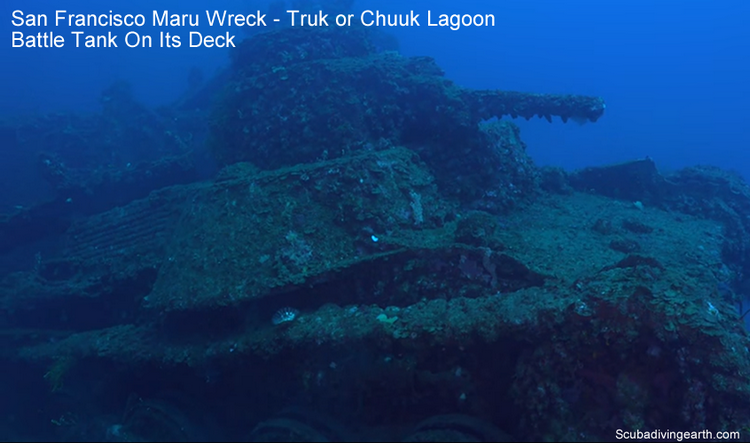
San Francisco Maru wreck
The San Francisco Maru wreck was a passenger cargo ship.
- She measures 117 metres (385 feet).
- She was 5,831 tons.
- The San Francisco Maru operated in world trade operations in minerals such as coal, bauxite, and phosphate for transportation to the Japanese Empire.
- She is sitting upright in 42-64 metres (140-210 feet) of water.
- Divers will get to see a bow gun, trucks, tanks, mines, shells, bombs, aircraft engines, ammunition, china and depth charges on stern.
- The San Francisco Maru was 117 metres (385 feet) in length and weighed 5,831 tons.
- This passenger-Cargo ship was built in 1919 for Yamashita Kisen Kabushiki Kaisha.
Video of the San Francisco Maru wreck
San Francisco Maru, Truk Lagoon wreck diving, deep dive, Type 95 Light Tanks, 37mm Deck Gun, Mines, Ammunition and equipment. This wreck sits upright and is still loaded with cargo. For wreck divers this is a Must!
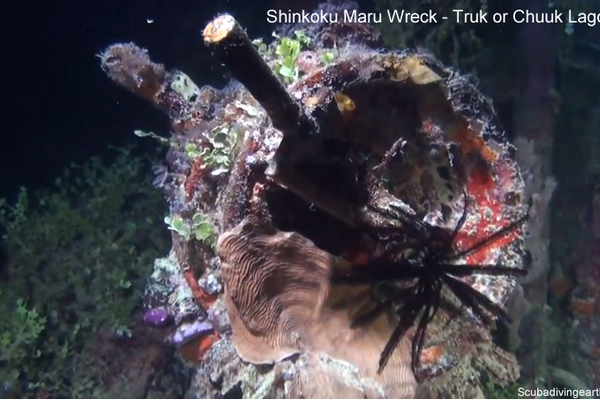
Shinkoku Maru wreck
The Shinkoku Maru wreck was a 152 metre (500 feet) long tanker weighing 10,020 tons.
- Like the Oite wreck this one demonstrates the true nature of this ghostly fleet that were sunk in Truk Lagoon.
- There are also bones to be found inside this wreck too. These are alongside bottles and men’s clothing and shoes.
- Also particularly noticeable on this wreck are the many beautiful soft corals and big schools of fish.
- You’ll find it easy to penetrate the engine room and superstructure of the Shinkoku Maru.
- She is at a depth of 12-40 metres (40-130 feet) on an even keel and upright.
- Shinkoku Maru only arrived at Truk on February 14th 1944, which was only three days prior to the carrier air strikes of Operation Hailstone.
- The name of this wreck has a symbolic meaning, where the name ‘Shinkoku’ means ‘divine country’.
- This is another of the Truk Or Chuuk Lagoon wrecks that has human remains in its midst.
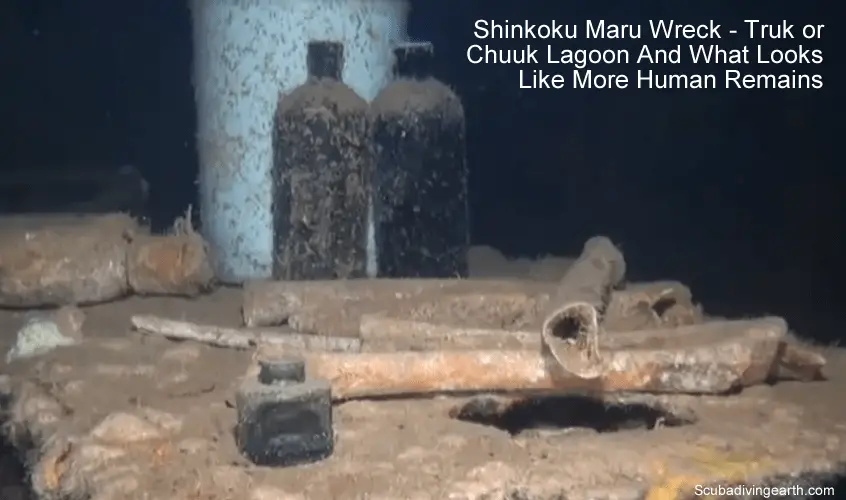
Video of the Shinkoku Maru wreck
While in Chuuk Lagoon during the summer of 2013, we were fortunate enough to do two dives on the Shinkoku Maru, aka “the Garden Wreck.” Our first dive was a daytime dive, while our second was a night time dive. Highlights of the dives included “shooting the stack” and plunging down the smokestack down to the bottom interior of the wreck, coral spawning at night(!), an operatory with artefacts, numerous treasures, and a whole lot of fun. Ensure that HD is activated, and enjoy! 🙂
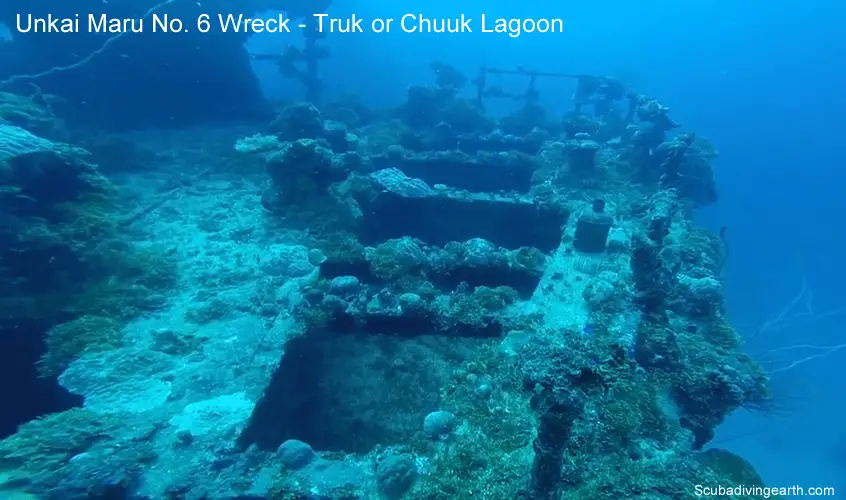
Unkai Maru No. 6 wreck
The Unkai Maru No. 6 wreck was a cargo ship.
- She was 100 metres (331 feet) in length.
- She weighed 3,100 tons and was built in Great Britain in 1905.
- The Unkai Maru was bombed on 17 February 1944 and set on fire, but remained afloat.
- It was on the second day of Operation Hailstone where Unkai Maru took several more hits and finally sunk on 18th February 1944.
- Now sitting upright at a depth of 24-50 metres (80-130 feet).
- Scuba divers that dive the Unkai Maru No. 6 will see the three inch bow gun.
- There are also many artefacts in the front hold, depth charges and an old steering mechanism at the stern to be seen.
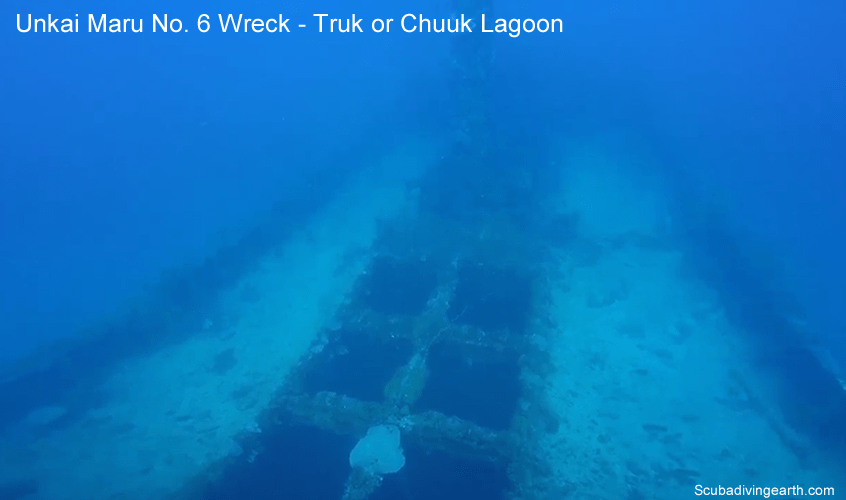
You’ll also see the collapsed smoke stack on the deck of this wreck, in addition to her schooner style stern too.
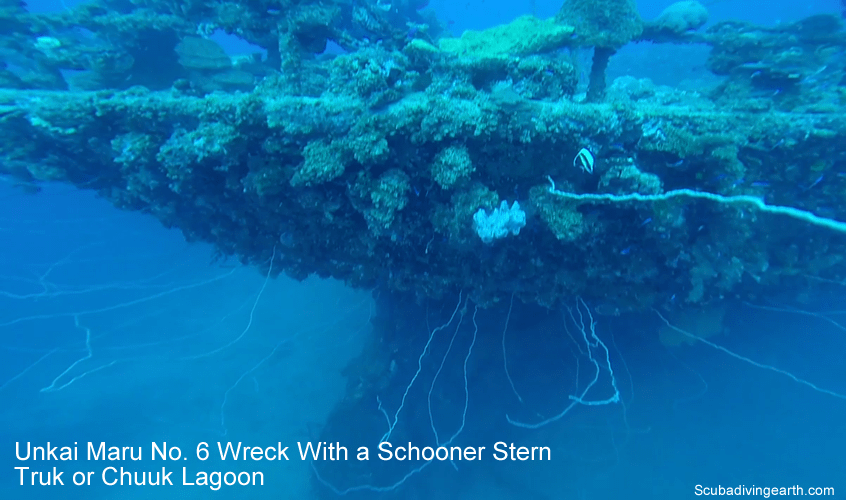
Unkai Maru was originally christened ‘Venus’, but the name was changed when Nakamuru Gumi purchased her in 1911. At the time, she was a relatively old coal fired steam ship. The word ‘Maru’ designates a merchant vessel.
She was requisitioned by the Japanese Navy late in the war on January 5th 1944. She only arrived into Truk on 30th January 1944.
Video of Unkai Maru wreck
A video tour of the wreck of Unkai Maru No 6 at Truk Lagoon. This 3,220grt Japanese naval auxiliary was built in Newcastle in 1905 as the SS Venus but was sold to Japanese shipping interests in 1921 and requisitioned by Japan in WWII. She was at anchor in the 6th Fleet anchorage north of Uman Island on 17 February 1944 when dive bombers from the U.S. fast carrier Task Force 58 attacked her. She was set on fire but remained afloat until the following day when she was attacked again. After taking several hits and near misses she sank into 40 metres of water.
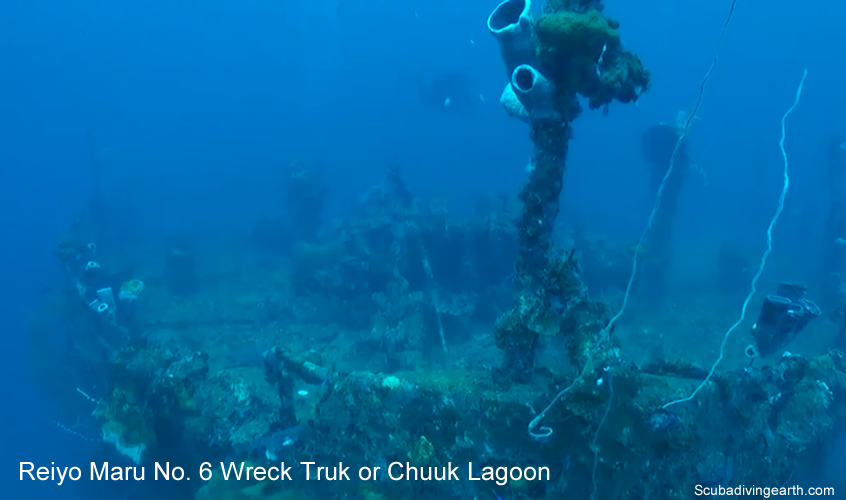
Reiyo Maru wreck
The Reiyo Maru wreck was a passenger cargo ship built in 1920.
- She was 121 metres (400 feet) long and weighed 5,446 tons.
- Reiyo Maru was sunk by US aircraft on the first day of Operation Hailstone.
- She was sunk by American dive bombers which came from the USS Essex.
- These bombers scored two direct hits with 1,000 lb. bombs.
- She is sitting upright in 50-65 metres (170-220 feet) of water.
- In the video below, it also proves that there are sharks to be seen in Chuuk Lagoon as well as many other coral reef fish.
Video of the Reiyo Maru wreck
Underwater video of the wreck of Reiyo Maru, one of the many Japanese shipwrecks at Truk Lagoon.
Planes in Chuuk or Truk Lagoon
What happened at Truk Lagoon has not only left ship wrecks, but also World War II planes too. The first of these World War II planes is ‘Betty Bomber‘.
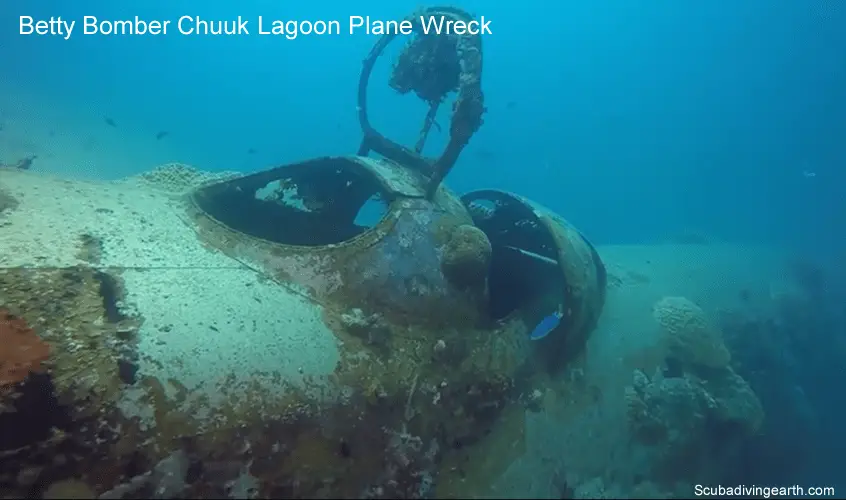
Betty Bomber Chuuk Lagoon plane wreck
Betty Bomber was a Mitsubishi G4M3 Navy Type 1 Attack Bomber, which first took to the air in 1939. Mass production began of this land-based attack aircraft in 1940.
- This aircraft was used by the Imperial Japanese Navy Air Service in World War II.
- It was the Allies that gave it the reported name ‘Betty’.
- But the Japanese name Hamaki was used, which means ‘cigar’ as the shape of its fuselage is that of a cigar.
- It would appear that this aircraft was landing at Ettea Island airstrip, but it unluckily went down just a few hundred metres short.
- Betty Bomber is sitting in much shallower waters than the ship wrecks of Chuuk Lagoon.
- She is resting at 15 metres (50 feet) and is upright.
- The nose is very broken and the engines are a good 50 metre (164 feet) swim off the starboard front side.
- This is because as they broke away from the plane, they travelled forward when it first crashed into the sea.
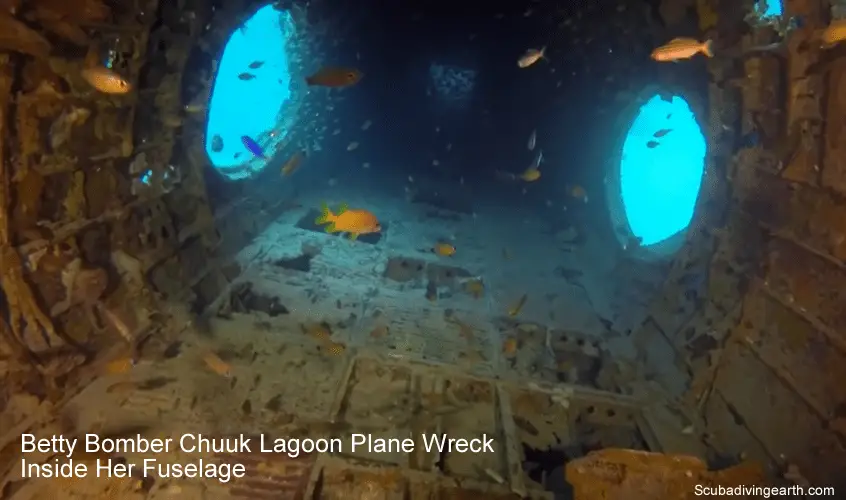
Video of Betty Bomber wreck
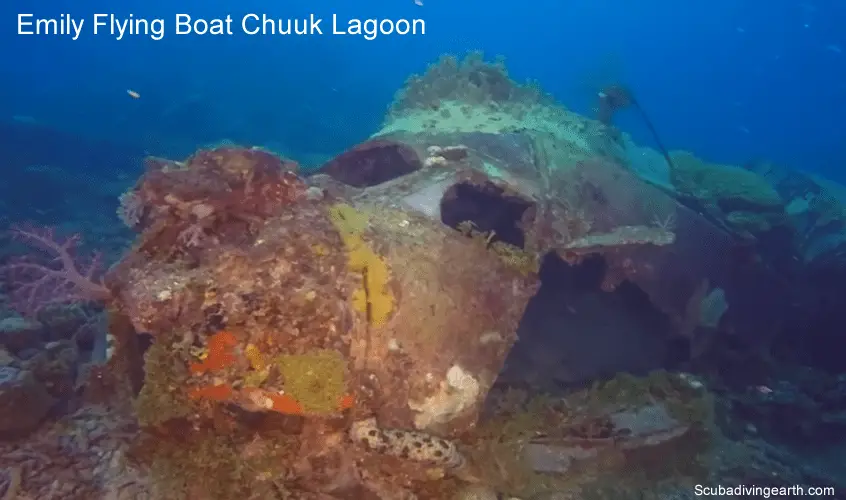
Emily Flying Boat Chuuk Lagoon
Emily Flying Boat is a Kawanishi H8K Navy Type 2 Flying-Boat.
- She was called the “Flying Porcupine” because she was armed with five 20mm cannons and four machine guns.
- Emily Flying Boat is 28 metres (92 feet) in length.
- Like Betty Bomber, Emily Flying Boat is at 15 metres (50 feet) deep.
- She is a massive plane wreck, which you’ll see from the image at the beginning of the video below and is lying upside down with the tail broken away.
- The engines look good with no propeller bends, which suggesting no impact – i.e. the plane sunk whilst moored
Video of Emily Flying Boat
A dive with Blue Lagoon Dive shop on the Japanese Kawanishi Flying Boat, as part of Minnesota School of Diving’s Truk and Palau trip Dec. 2014
Oceanographer Jacques Cousteau made Truk Lagoon famous
It was in 1969 that French scuba diver Jacques Cousteau, together with William A. Brown and his team explored the wrecks of Truk Lagoon.
This exploration was made into a television documentary in 1971. This documentary highlighted Truk’s ghostly human remains and the vast number of wrecks. As a result Truk became a scuba diver’s paradise.
For those wreck diving enthusiasts from around the world, Truk Lagoon became the best place to experience a large number of wrecks, which were mostly virtually intact, and all in one place.
The wrecks around Chuuk or Truk Lagoon are scattered around the islands of Dublon, Eten, Fefan (marked on the map above) and Uman (marked on the map above).
The best parts to diving Truk Lagoon is the visibility is usually great and the waters warm.
What is Truk or Chuuk Lagoon like to scuba dive?
Chuuk Lagoon is relatively easy to dive, as the surrounding reef protects the lagoon from any nearby strong currents.
There are two ways to scuba dive Chuuk Lagoon, which is either land-based or on a Truk Lagoon liveaboard dive trip.
However, as you will have seen many of the wrecks are deep. This means that in order to dive Chuuk Lagoon and the wrecks, you will need to be a deep diver (30 plus metres) or a technical diver.
You are probably better to consider diving on a rebreather too.
I hope you enjoyed this article about what happened at Truk Lagoon
I’d love to hear from you. Tell us about your adventures of diving and snorkeling, in the comments below. Please also share your photos. Either from your underwater cameras or videos from your waterproof Gopro’s!
If this article hasn’t answered all of your questions. If you have more questions either about snorkeling or scuba diving (or specifically about what happened at Truk Lagoon), please comment below with your questions.
There will also be many more articles about scuba diving (and snorkeling) for you to read and learn about these fabulous sports.
Have fun and be safe!

